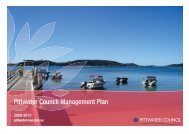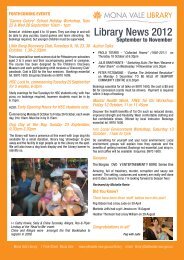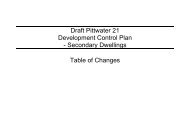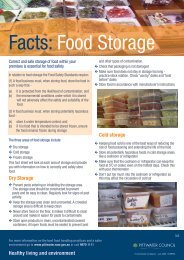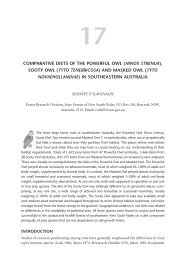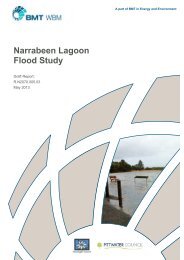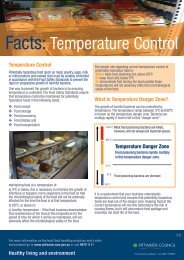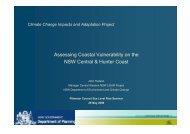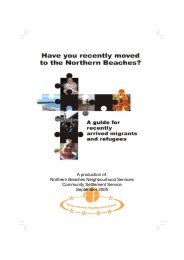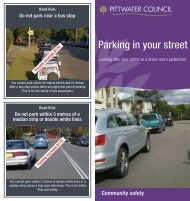Pittwater 2012 Bushfire Prone Land Map - Pittwater Council
Pittwater 2012 Bushfire Prone Land Map - Pittwater Council
Pittwater 2012 Bushfire Prone Land Map - Pittwater Council
Create successful ePaper yourself
Turn your PDF publications into a flip-book with our unique Google optimized e-Paper software.
<strong>Pittwater</strong> <strong>2012</strong> <strong>Bushfire</strong> <strong>Prone</strong> <strong>Land</strong> <strong>Map</strong><br />
Frequently Asked Questions<br />
What is <strong>Bushfire</strong> <strong>Prone</strong> <strong>Land</strong>?<br />
<strong>Bushfire</strong> prone land is land that falls within or partially within a<br />
bushfire prone area, which can support a bushfire or is likely to<br />
be subject to bushfire attack. In general, a bushfire prone area<br />
occurs in or within 100 metres of a high or medium bushfire<br />
hazard.<br />
How are bushfire hazards managed in <strong>Pittwater</strong>?<br />
<strong>Pittwater</strong> contains a great deal of native bushland on its headlands,<br />
parks and reserves. <strong>Pittwater</strong> <strong>Council</strong> works closely with the Rural<br />
Fire Service to mitigate risk from bushfire in bushfire prone areas<br />
through urban planning and fuel hazard reduction.<br />
Why do we need a bushfire prone land map?<br />
State government laws on bushfire protection ensure that people,<br />
property and the environment are more fully protected against the<br />
dangers that may arise from bushfires.<br />
As a result, all NSW councils are required to regularly review and<br />
update their maps of bush fire prone land.<br />
The draft <strong>Pittwater</strong> <strong>2012</strong> <strong>Bushfire</strong> <strong>Prone</strong> <strong>Land</strong> <strong>Map</strong> is on public<br />
exhibition between 23 February and 30 March <strong>2012</strong> and following<br />
adoption by <strong>Council</strong>, will be certified by the Commissioner of the<br />
NSW Rural Fire Service. All development applications lodged<br />
before certification of the map will be assessed against the<br />
current <strong>Pittwater</strong> <strong>Bushfire</strong> <strong>Prone</strong> <strong>Land</strong> <strong>Map</strong>.<br />
Where can I view <strong>Pittwater</strong>’s draft <strong>Map</strong>?<br />
The <strong>Map</strong> is available on the <strong>Council</strong>’s website at www.pittwater.<br />
nsw.gov.au. During public exhibition of the draft <strong>Map</strong> between<br />
23 February and 30 March, it will also be available for viewing<br />
at <strong>Pittwater</strong> <strong>Council</strong>’s customer service centres and libraries (at<br />
1 Park Street Mona Vale and 59A Old Barrenjoey Road Avalon).<br />
What do the colours on the <strong>Map</strong> represent?<br />
A property is deemed to be bushfire prone land if it is wholly or<br />
partly located in the red, orange or yellow area on the draft <strong>Map</strong>.<br />
How do I know if my home is bushfire prone?<br />
Letters are being sent to affected property-owners. As mentioned<br />
previously, the new draft map is available on <strong>Council</strong>’s website<br />
and customer service centres. To confirm whether your property<br />
is identified on the existing map, visit www.pittwater.nsw.gov.au/<br />
building_and_development/mapping<br />
How has the mapping been carried out?<br />
The <strong>Pittwater</strong> <strong>2012</strong> <strong>Bushfire</strong> <strong>Prone</strong> <strong>Land</strong> <strong>Map</strong> has been prepared<br />
in accordance with the NSW Rural Fire Service Guidelines.<br />
The new map used aerial photography and compared bush fire<br />
prone vegetation mapping with the <strong>Council</strong>’s existing vegetation<br />
mapping. This was to determine the accuracy of the vegetation<br />
boundaries and vegetation type (which influences the bushfire<br />
vegetation categories and the final <strong>Bushfire</strong> <strong>Prone</strong> <strong>Land</strong>s <strong>Map</strong>).<br />
Vegetation edges were reduced by 2 metres to reduce any errors<br />
associated with aerial photography and this removed a number<br />
of properties just clipped by the existing <strong>Bushfire</strong> <strong>Prone</strong> <strong>Land</strong><br />
<strong>Map</strong>. All new areas of vegetation were re-examined to ensure<br />
vegetation boundaries and vegetation categories were correct<br />
under the guidelines. Finally the new Draft Bush Fire <strong>Prone</strong> <strong>Land</strong><br />
<strong>Map</strong> was reviewed by the NSW Rural Fire Service before public<br />
exhibition.<br />
A comparison map highlighting the difference between the 2004<br />
<strong>Bushfire</strong> <strong>Prone</strong> <strong>Land</strong> <strong>Map</strong> and the draft <strong>2012</strong> Bush Fire <strong>Prone</strong><br />
<strong>Map</strong> is available on <strong>Council</strong>’s website at<br />
www.pittwater.nsw.gov.au/exhibition<br />
Info Flyer for letters - Bush Fire <strong>Prone</strong> <strong>Land</strong> <strong>Map</strong> <strong>2012</strong>.indd 1<br />
22/02/<strong>2012</strong> 5:06:34 PM
How does the map affect development of affected<br />
properties?<br />
Since August 2002, legal standards have been in place for the<br />
safe construction of buildings in bushfire prone areas in NSW.<br />
These standards are set out in the Planning for <strong>Bushfire</strong> Protection<br />
Guidelines 2006 and must be addressed in the preparation of<br />
a development application for land identified on the <strong>Pittwater</strong><br />
<strong>Bushfire</strong> <strong>Prone</strong> <strong>Land</strong> <strong>Map</strong>. Standards include; adequate setbacks<br />
from bushland; inclusion of reduced fuel areas (Asset Protection<br />
Zones); correct positioning of the building and good access roads<br />
for firefighters and residents.<br />
<strong>Bushfire</strong> protection standards must be included in development<br />
applications for existing or proposed development in bushfire<br />
prone areas. Development applications on bushfire prone land<br />
are assessed by the <strong>Council</strong> and the Rural Fire Service.<br />
All development on bushfire prone land requires a <strong>Bushfire</strong> Risk<br />
Assessment and certification prepared by a suitably qualified<br />
consultant - these are required irrespective of whether your<br />
property is fully or partially included in the <strong>Map</strong>.<br />
For further information - refer to www.rfs.nsw.gov.au<br />
‘Building in a Bush Fire <strong>Prone</strong> Area – Frequently Asked Questions’<br />
State Environmental Planning Policy (Exempt and<br />
Complying Development Codes)<br />
As of 25 February 2011, land identified as being bushfire prone<br />
is no longer excluded from the SEPP Codes. Instead, specified<br />
development requirements and standards apply to new SEPP<br />
development undertaken on low risk bushfire prone land.<br />
Development standards have been designed to ensure that<br />
complying development is not allowed on higher risk bushfire<br />
prone land i.e. BAL-40 or Flame Zone (the distance from a<br />
bushfire at which there is significant potential for sustained flame<br />
contact to a building). Complying development on bushfire prone<br />
land will require a <strong>Bushfire</strong> Affected Level (BAL) certificate under<br />
the Planning for <strong>Bushfire</strong> Protection Guidelines 2006 prepared<br />
by a suitably qualified consultant.<br />
Subdivision or Integrated Development on <strong>Bushfire</strong><br />
<strong>Prone</strong> <strong>Land</strong><br />
A development application for a ‘Subdivision’ or ‘Integrated<br />
Development’ (as defined under Section 100B of the Rural Fires<br />
Act, e.g. school, nursing home, State Environmental Planning<br />
Policy (Housing for Seniors or People with a Disability 2004)),<br />
also requires an accompanying <strong>Bushfire</strong> Risk Assessment<br />
prepared by a suitably qualified consultant and a <strong>Bushfire</strong> Safety<br />
Authority (BFSA) Report from the NSW Rural Fire Service.<br />
When will the new <strong>Bushfire</strong> <strong>Prone</strong> <strong>Land</strong> <strong>Map</strong> apply?<br />
The existing <strong>Bushfire</strong> <strong>Prone</strong> <strong>Land</strong> <strong>Map</strong> will remain in place until<br />
the <strong>2012</strong> Bush Fire <strong>Prone</strong> <strong>Land</strong> <strong>Map</strong> is certified by the NSW<br />
Rural Fire Service Commissioner. All development applications<br />
lodged before this date will be assessed against the previous<br />
<strong>Pittwater</strong> <strong>Bushfire</strong> <strong>Prone</strong> <strong>Land</strong> <strong>Map</strong>.<br />
How often will the <strong>Pittwater</strong> <strong>Bushfire</strong> <strong>Prone</strong> <strong>Land</strong><br />
<strong>Map</strong> be reviewed?<br />
It will be reviewed by the <strong>Council</strong> in consultation with the Rural<br />
Fire Service every five years.<br />
For more information:<br />
Contact Officer: Mark Beharrell<br />
Manager, Natural Environment & Education<br />
Phone: 02 9970 1368<br />
Email:<br />
mark_beharrell@pittwater.nsw.gov.au<br />
www.pittwater.nsw.gov.au/exhibition<br />
Follow us on Twitter! about<strong>Pittwater</strong> Find us on Facebook - I Love <strong>Pittwater</strong><br />
Info Flyer for letters - Bush Fire <strong>Prone</strong> <strong>Land</strong> <strong>Map</strong> <strong>2012</strong>.indd 2<br />
22/02/<strong>2012</strong> 5:06:34 PM




